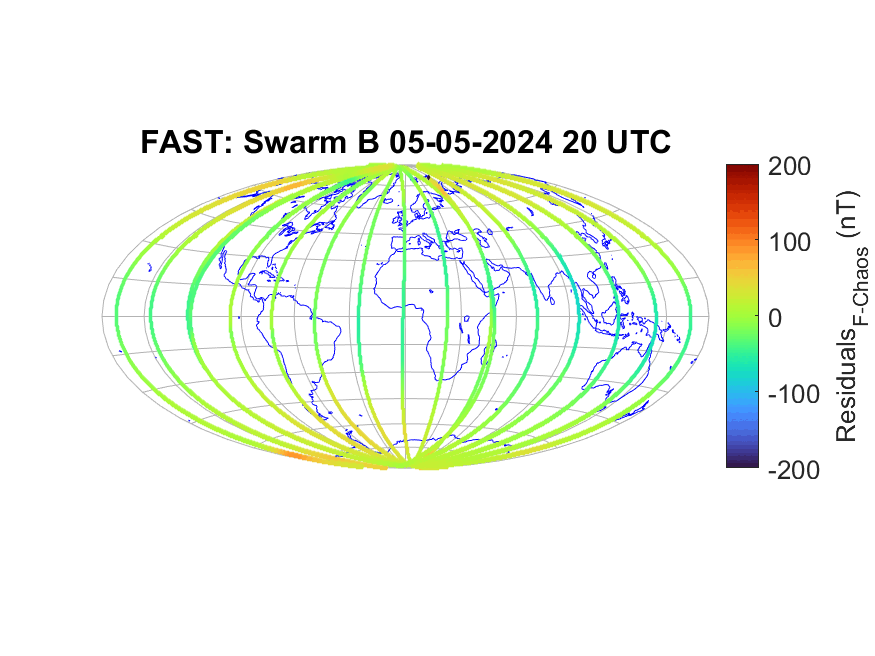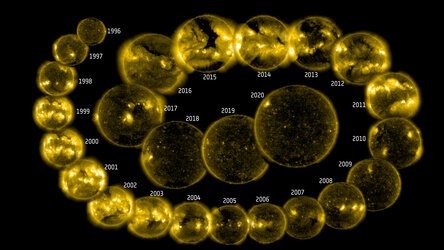The May 2024 solar storm: your questions answered
In brief
Last weekend, the biggest solar storm to hit Earth in over 20 years swept over our planet as the Sun’s activity ramps up to the peak of its current solar cycle. The storm created beautiful auroras, causing skies to sparkle and dance at much lower latitudes than usual.
Let’s answer some questions you may have after witnessing the spectacle. What happened? Are solar storms dangerous? How was Earth affected? Can ESA predict space weather? Here’s what you need to know.
In-depth
What happened?
Activity on the surface of the Sun generates space weather that spreads outwards, across the Solar System. Last week, a very large active region on the Sun facing our planet erupted multiple times and hurled a big solar storm in the direction of Earth.
Several large solar flares and a series of coronal mass ejections (CMEs) were directed towards Earth, sending large amounts of fast-moving magnetised plasma through space towards our planet.


Access the video
While the magnetic field of our planet shields us from most of such activity, this time, the protective layer was stretched and stressed to an unusually high degree. Charged particles interacted with our atmosphere and produced auroras, not only in the polar regions, but also at much lower latitudes.
Why was this storm so big?
Depending on where the Sun is in its 11-year solar cycle, we experience periods of high or low solar activity. We are now approaching the peak of solar activity in the current cycle. Large solar storms are common as we approach solar maximum.
The Sun has spent the past half a decade increasingly twisting and contorting its magnetic field. Close to solar maximum, like we are now, this magnetic field has become so entangled that, at times, it snaps. Like an elastic band that has been stretched too far, a solar magnetic field line can snap, ejecting large volumes of plasma at high velocities, electromagnetic radiation and high-energy particles.
Are such big solar storms dangerous?

Major space weather disturbances are not directly dangerous to anyone on the surface of Earth because we are shielded by our planet’s magnetic field and atmosphere. Some geomagnetic storms may be accompanied by energetic particles which may pose a limited risk to flights at high latitudes and altitudes, so these may be rerouted to avoid potential communication and navigation problems or unnecessary exposure.
For astronauts who are beyond the protective shell of our atmosphere, and for the lunar explorers of the future, potentially also our magnetic field, it is important that they receive a timely warning of incoming space weather to give them time to react.
Our Sun’s outbursts also have the potential to disrupt and damage satellites as well as vital infrastructure on the ground like power grids and radio communications. This includes critical infrastructure dependent on satellites like navigation and telecommunication, and an increasing number of less intuitive yet equally critical systems such as banking transactions.
Timely warnings are of the essence to be able to protect astronauts as well as vulnerable infrastructure.
Did we see this storm coming?
Big solar storms are common so close to solar maximum. Although it is possible to forecast the probability of an eruption, the exact moment of the event – when the elastic band snaps – and the precise magnitude are still difficult to predict.
The big active areas on the Sun’s surface are closely monitored at all times and ESA maintains a host of space weather services used by industry and spacecraft operators to be able to respond quickly to a space weather event.
The effects of last week’s eruptions were closely monitored as they travelled to Earth. In the case of solar flares, electromagnetic waves travel at the speed of light, so we do not have much time to react. The matter thrown out by coronal mass ejections travels much slower, giving us more time to prepare in advance for any potential impact. They may take up to several days to reach Earth, depending on their speed.
How was Earth affected?

Solar activity impacts our planet and our technology in different ways. Electromagnetic radiation in the form of radio waves, X-rays and UV light, for example, can disturb radio communications on the dayside of Earth. There are also highly energetic particles that can penetrate the materials of spacecraft and potentially damage them. High-speed coronal mass ejections interact with our magnetic environment, leading to phenomena such as induced currents in long power lines and the aurora.
It is the latter phenomenon that had a higher visible impact last weekend, producing spectacular auroras over a very broad range of latitudes. We are still evaluating the impact of this exceptional storm on our technology and are in contact with space weather service users in a wide range of affected sectors to understand any preparations that they made for this event, how they responded during the event, and whether they experienced any negative impacts.
How were ESA missions affected?

ESA spacecraft are hardened against radiation and none were damaged as a result of this storm.
For missions in low-Earth orbit, the bigger challenge comes after the storm. Intense space weather causes Earth’s atmosphere to swell, changing the level of drag that satellites experience and making them work hard to stay on track. Changes in atmospheric drag also make it harder to accurately track the positions of pieces of space debris. During periods of high solar activity, satellites have to carry out more and larger space debris avoidance manoeuvres to ensure they are not at risk of collision.
Spacecraft in elliptical orbits that are sometimes out beyond Earth’s protection, such as ESA’s Integral, detected a strong signal from the large solar flare on 11 May. Radiation data detected by all ESA missions is currently being gathered and analysed. The ESA/NASA Solar and Heliospheric Observatory (SOHO) at the first Lagrange point was impacted by the storm just before Earth was, but that is exactly why we put spacecraft at L1, to monitor the Sun and detect space weather before it gets to Earth.
What will happen next?
The solar region responsible for the weekend’s storm has rotated out of view from Earth – taking us out of the potential impact zone. However, two new very active solar regions are already coming into view. While we can’t make concrete predictions, these new active regions will be closely monitored as more space weather events might come our way.
At the same time, our specialists are working tirelessly to record all the observed impacts on our technology – and ultimately on our economy – to keep improving our ability to predict and mitigate the effects of such storms.
What is ESA doing about Space Weather?

At ESA, monitoring current space weather is a core activity of our Space Weather Office, part of the Agency’s Space Safety Programme. Their goal is to continuously observe, monitor, understand and predict all potential hazards emanating from our star. Our growing space weather service network provides pre-operational space weather services to end users in the many different industries and organisations impacted by space weather.
At ESA, we have multiple missions and instruments studying the Sun, because learning about our star is key to predicting its potentially hazardous activity. This includes missions such as Solar Orbiter, SOHO, Proba-2 and the upcoming Proba-3.
Other missions, including Cluster, Swarm and SMOS, measure the effects of solar activity at Earth and increase our understanding of how our atmosphere and magnetic field work. In the coming years, ESA will launch Smile, to view the full Sun–Earth connection, and the Aurora mission, to continuously monitor Earth’s aurora.
Space weather services will greatly improve once ESA’s Vigil mission launches in 2031. Vigil will monitor the side of the Sun, spotting areas of potentially hazardous solar activity days before they rotate into view of Earth.
Vigil will provide ESA’s first 24/7 operational data from deep space and increase our advance warnings up to 4—5 days in some cases, allowing us to be much more prepared for hazardous solar events, including potentially destructive geomagnetic storms.














 Germany
Germany
 Austria
Austria
 Belgium
Belgium
 Denmark
Denmark
 Spain
Spain
 Estonia
Estonia
 Finland
Finland
 France
France
 Greece
Greece
 Hungary
Hungary
 Ireland
Ireland
 Italy
Italy
 Luxembourg
Luxembourg
 Norway
Norway
 The Netherlands
The Netherlands
 Poland
Poland
 Portugal
Portugal
 Czechia
Czechia
 Romania
Romania
 United Kingdom
United Kingdom
 Slovenia
Slovenia
 Sweden
Sweden
 Switzerland
Switzerland


































